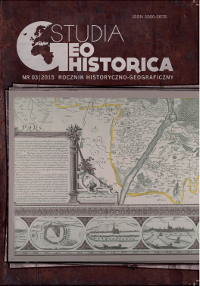Historyczne założenia obronne, architectura militaris i LiDAR. Wybrane zagadnienia metodyczne z zakresu zastosowania skanowania laserowego w detekcji i inwentaryzacji nowożytnych fortyfikacji
Historic Defence Structures – Architectura Militaris and LiDAR. Chosen Aspects in the Methodology of Implementing Laser Scanning for the Detection and Documentation of Modern Fortifications
Author(s): Rafał ZapłataSubject(s): Human Geography
Published by: Polskie Towarzystwo Historyczne
Keywords: architectura militaris;fortyfikacje nowożytne;skanowanie laserowe;architectura militaris;modern fortifi cations;airborne laser scanning;GIS
Summary/Abstract: In recent years, research of defence structures, including modern fortifications, has been advanced by the possibility of verification and documentation of historic structures with the use of aerial laser scanning (ALS). The potential of those state-of-the-art methods is more and more often noticed in literature. Literature focuses so far on permanent fortifi cations and bases on generally known processing methods and visualisations of geodata, such as hill-shading. Thus, worth stressing is the potential and functionalities of ALS for research of field fortifications or destroyed, levelled and barely visible parts of military fortifications. With reference to research methodology, this article stresses the importance and potential not only of spatial analyses and ALS data, but also of their processing methods and of visualisations. The latter two, available in different formats, introduce a new element in the recognition, interpretation and documentation of modern defence structures. A separate aim of this article is to draw attention to growing possibilities of the analysed technology, especially to the so called fourth dimension – registration and analysis of the intensity of reflected laser radiation. The article analyses primarily chosen aspects of methodology connected with research and documentation of modern historic structures, based on laser scanning. It also stresses the efficacy of modern remote sensing technologies for research and protection of heritage, focusing on several important issues connected with the quality of data, their processing, analysis and interpretation and well as on the characteristic environment in which military structures are found – forested areas. Practice and experience acquired so far indicate that after an introductory period of implementing such methods, certain problems connected with the acquisition of data should be pointed out, along with several important research postulates connected with the usage and improvement of hitherto applied research practice. Th e article consists of four main sections: introduction, a section devoted to historic fortifications, technology of laser scanning and different kinds of data processing, and summary. The subject matter is referred to in the light of literature and of own research results, which include analyses of fortifications from the vicinity of Pakosław in Mazovia and of the Srebrna Góra Fortress in Lower Silesia. Research work funded by the Ministry of Science and Higher Education under the “National Programme for the Development of Humanities” in 2012–2015.
Journal: Studia Geohistorica
- Issue Year: 2015
- Issue No: 3
- Page Range: 150-174
- Page Count: 25
- Language: Polish

